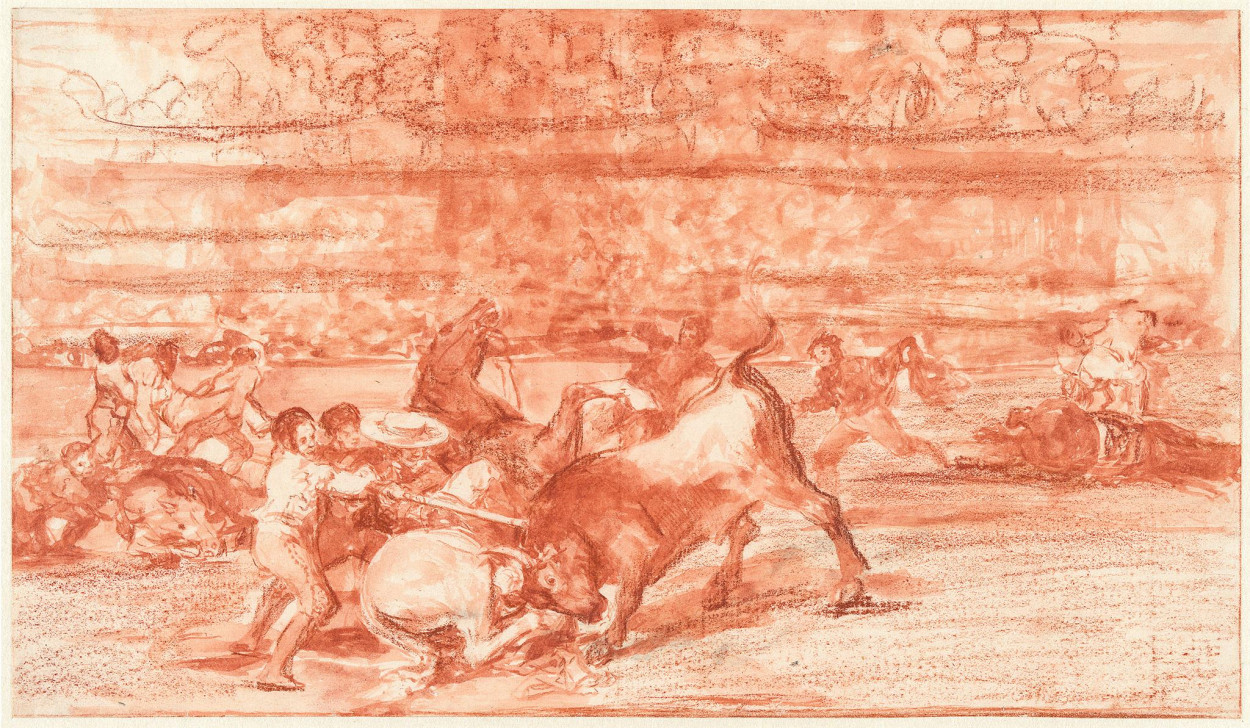
Francisco José de Goya y Lucientes, Zeichner
Zwei Gruppen von Picadores werden von einem einzigen Stier geworfen (Vorzeichnung zur Tauromaquia, Platte 32), 1814 - 1816
The preparatory drawings for Francisco de Goya's Tauromaquia show a formal evolution toward increasingly complex compositional and technical approaches, as in the case of this sketch for print number 32. It resembles three other drawings from this series in its combination of red chalk and red-ink wash: 27 (Madrid, Museo Nacional del Prado, D 4314), E, and K (both in the Hamburger Kunsthalle, inv. 38533 and 38542, cat. nos. 65 and 66). Perhaps because of their different style and provenance, Enrique Lafuente Ferrari expressed doubts about the authenticity of the drawings from Hamburg, which he related to the “goyesco drawing factories” that produced numerous fakes and imitations over the course of the nineteenth century.[1] Those copies posed problems for the sale, reception, and study of Goya's work during the nineteenth and twentieth centuries. Except for Lafuente Ferrari, who examined the problem generated by the work of Goya's followers and imitators some years later,[2] no one has published questions regarding these drawings, although some doubts remain, as Gassier himself reflected in his catalogue raisonné of Goya's drawings.[3]
Now, however, comparison of the original with the print reveals a series of technical clues that corroborate the authenticity of these drawings and their transfer to the copper plate, despite the compositional changes that Goya made during their posterior etching. Goya maintained the figures' essential elements, and both their size and the placement of their contours correspond exactly to those of the drawing. As has been pointed out with regard to other drawings from this series, Goya made a contact transfer of the drawn image to the copper plate, whose previous coat of protective varnish then retained light traces of the red chalk that he subsequently went over with a metal point, leaving a very light incision in the varnish of the plate. The submersion of the plates in acid then left a tenuous compositional guide to the figures' contours that offered Goya a starting point for precisely engraving them, removing or adding whatever he considered necessary. In most cases, it is impossible to detect the preliminary engraving as it is underneath the definitive grooves, but here, the print shows some strokes that coincide with the figures in the drawing which Goya decided not to engrave. Behind the dead horse, on the right side of the drawing, is a group of figures backing away from the fatal encounter while, behind the bull, an assistant hurries to try and distract it. At exactly the same places on the print, one finds subtle lines that are barely visible beneath the posterior addition of intense hatching and aquatint. These lines document the initial idea and the subsequent decision to eliminate it.
The intense drama of accidents suffered by picadors greatly interested Goya. That fact is clear throughout the series, where tragedy and action dominate: horses and bullfighters being gored, fearful retinues, and the bull as a metaphor for an unstoppable force that topples anything in its path.
With his Cartas de España, José Blanco White described the tension and barbarity of this particular part of the bullfight:
"the bull, infuriated by the lance's wound, turned on the other picador, whose horse was less responsive to the helpers and thus received such a terrible goring in its chest that it fell dead on the spot. The strength of the bull's attack unseated the picador, throwing him to the other side of the horse. There was a profound silence and the spectators rose from their seats to fearfully watch the wild beast furiously goring the wounded horse while the picador, whose only chance at salvation lay in remaining immobile, looked dead. The tragic scene lasted only a few moments, as the men standing around ran to the bull from all directions, waving their capes to catch his attention."[4]
Blanco White goes on to narrate successive encounters between the bull and the horses, “in which he wounded four and killed two,' and ends by summing up the cruelty of such events: “These horses have not been especially trained for bullfights. Instead, they are purchased for thirty or forty shillings when, exhausted by work or weakened by illness, they are no longer capable of any other service.” The scene recalls the Disasters of War, especially those prints of clashes between Spaniards and Frenchmen such as Con razón o sin ella, or Al cementerio. Formally, the similarities are so notable that the two series clearly share the same ideological approach. The Disasters constitute a furious criticism of the senselessness of violence, and the Tauromaquia is no different, as irrationality and its tragic consequences for humans and animals are omnipresent.
José Manuel Matilla
1 Lafuente Ferrari 1941, 186.
2 Lafuente Ferrari 1947b.
3 Gassier 1975, no. 274.
4 José Blanco White, Cartas de España, ed. Antonio Garnica (Seville: Universidad de Sevilla, 2001), fourth letter, 187–88.
